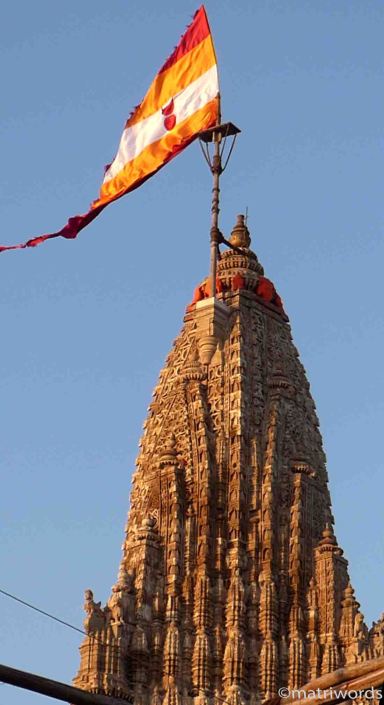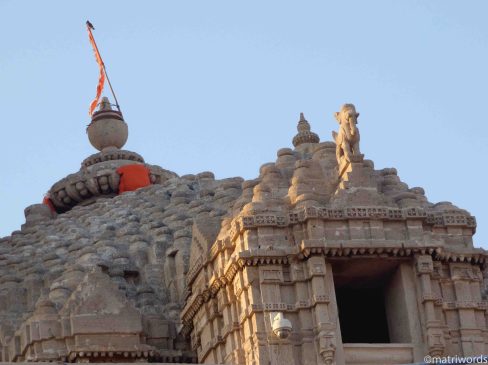We both stood still. For a few minutes, we just stood there.
As the evening aarti at the temple was about to begin, we just stood there. Struck. In awe. In silence. At the entrance of this magnificent – no that’s not the right word for it but can’t think of anything else – temple.
This was no ordinary temple. This was something else. That something else which made us stop there, right at the entrance of it, could it have been only the externals? No, it can’t be.

It’s not that the temple isn’t a grand one in its externals, though not like one of those Chola marvels or Hoysala beauties. But there was something so inwardly grand, so regally divine about it. Something so out-of-this-earth, indeed a heavenly structure brought down on earth.

The Jagat Mandir, or better known as Dwarkadhish temple, in Dwarka, Gujarat is the abode of Lord of Dwarka, Sri Krishna as Rajadhiraj. The temple’s history dates back to about 2500 years, and it is believed that it was Sri Krishna’s grandson Vajranabh who first got a temple built in memory of his divine ancestor.
The town of Dwarka is believed to have been submerged in the Arabian sea six times and the present town is the seventh reincarnation of the holy abode of Lord Dwarkadish. Known in India as one of the Moksha-dwar, gateway to Moskha (liberation), Dwarka, the city built by Sri Krishna and its legendary temple are considered as one of the four significant places of pilgrimage (char dham) for devout Hindus. Read more about the fascinating history of Dwarka here.
The magnificently and spell-binding five-storied Dwarkadish temple, in its present form, with its carved columns and two entrances – Moksha Dwar and Swarga Dwar – is built in Chalukyan style, constructed in 15-16th century. The Sun and Moon bearing mandir-dhwaja, the temple’s flag, is changed five times during the day. A brief historical timeline of the temple can be accessed here.

But all that is of scholarly interest.
What stopped us in our tracks the moment we came face to face with the temple was something else. Something that only the heart can feel, something that only the inner eyes can see. And maybe something that is experienced, recorded, remembered (or is it recalled?) by that something or someone hidden deep inside us.
My husband’s way of describing any such experience is through his camera. Because there is no photography allowed anywhere inside the premises of the temple, he had to content himself by taking a few shots from the outer complex near the security gates and from the main temple street.

Let me see if I can describe what I felt through words. It was this palpable feeling of recognition that this IS indeed the Lord’s place, the place from where while outwardly running the affairs of his kingdom he was always inwardly working and arranging to establish a reign of Dharma, to unify the disparate regions of Bharatvarsha under the one flag of Dharma-rajya. And with this recognition many stories from the Mahabharata came alive in front of the eyes.
What was also very palpable was that even though Dwarka is Sri Krishna’s karmabhoomi – and his field of karma was as grand and noble as the punyabhoomi of Bharat – there is also such an intense feeling of Joy, Ananda, that sweeps over you as soon as you enter the temple premises, the feeling that the Indian heart and mind have come to associate with Sri Krishna, his life and work.
The joy of anticipation of meeting the Lord in his regal shringar, befitting a king of kings.
The joy that is pouring through the beats of the dhol as the aarti begins.
The joy that unites all the bhaktas standing in the darshan queue in one universal embrace of the love for the Lord.
The joy that melts through the eyes when you are in front of the Lord, the joy that is beyond all description.
There is a lot more I could say about the very special Darshan we had at Dwarkadish temple. But there is a whole lot more that would still be left unsaid. Because it simply can’t be said. It has to be experienced.
All I can say is – thank you, Lord for blessing me with the experience.
Linking with Vidya Sury’s June Gratitude Circle 




This just took me back to the days when I used to spend time in a temple daily in Gurgaon. The peace one attains while being there can’t be described in words.
Yes, pictures have done justice here…happy reading 👍
Thanks Alok for reading and sharing about your experience.
Blissful..and you remarkably made your readers awestruck with this marvellous temple. We never seem to have enough of the rich and heavenly abode ..and similar is the Somnath temple thar keeps me mesmerized and longing for more..an eternal sight to the starved eyes..
Thanks for the marvel Beloo..
Thank you, I am happy this post resonated so well with you.
Hopefully, with Lord’s grace someday I will find myself in the right mood to write about my experience at Somnath.
Waiting with bated breath for the Somnath travelogue
When the Bholenath wills 🙂
Your description makes me want to visit… and experience…. this beauty too. Someday… maybe.
His flute decides the timing of his call 🙂 But you would love it there, I am sure of that!
Some divine moments like this one truly need to be experienced as is clear from the fact that someone as eloquent as you confesses to be at a loss for words! I have not viisted any temple in Gujarat, except the Hutteesingh Jain Temple in Ahmedabad. Hope I get that flute call to visit Dwarka and the dumroo beats to visit Somnath, two temples that I so want to visit.
We also visited Hutteesingh Jain Temple in Ahmedabad. It is beautiful, in every way. Got a chance to witness some women performing traditional Jain rituals. I wish I could fully understand what each action symbolised, though the essence was somewhat clear behind the offerings of rice, money etc.
Yes, both Dwarka and Somnath are absolutely special. And I also hope you soon get the call of the flute and dumroo to experience the magic there.
Thanks, Zephyr!
Oh yes! What an experience that must have been. I have only had this kind of experience when I visited Golden Temple a couple of years back. Somehow all the seva and a warm, generous feel gives an unreal sense of elation, of joy, of feeling close to all the good that is there in the world. Let’s see when the call comes to visit Dwarka.
Someday I hope to visit the Golden Temple! Last time I was in Punjab was more than three decades ago.
Something so uniquely fulfilling and joyful about tirtha yatra! Thanks, Rachna.
Sometimes a temple needn’t be the biggest or the grandest. It gives out such a peaceful vibe that it’s enough to entrance you. I dislike the overly crowded hyped ones – there never is any peace or quiet there or even a moment for a dialogue with God. This one looks beautiful. You make me want to visit it.
I think each temple has its own aura and presence and perhaps serving a unique purpose for the community nearby. Some call me inside, some not so. I suppose it is about some inner resonance with the energy of that temple. Personally, even in the most crowded ones like Siddhi Vinayak temple in Mumbai or Meenakshi temple in Madurai, I have been able to find moments of quiet and serenity. But yes, often the crowds, especially on certain important festival days can be difficult to navigate through.
The temple in Dwarka is actually quite grand in its way, but it doesn’t impose itself architecturally like the Meenakshi temple, for instance or even Somnath. But its grandness is more of what it symbolises. At least that’s how I felt. I hope you get a chance to visit there sometime.
The beauty of the spirit, and the energy of a place of worship. Thanks for sharing.
Thanks, Damyanti for reading and sharing.
Hey nice post…and like you ended, ‘all I can say is …thank you for such a lovely experience’ .. God bless
Thank you 🙂
My pleasure
The temple is gorgeous, Beloo and so is your lyrical post. I’ve always felt my heart pound when I hear the aarti – it is like being pulled into the divine and cleansed, and being told that everything will work out, and everything will be okay. I have that feeling regardless of the temple. It must be the something special about the temple bell. And I am always surprised to find that tears have been streaming down my face. Hugs and thank you so much for linking up. I feel blessed.
Thank you, Vidya for your wonderful comment. I am convinced that it is all a matter of the nature of energy inside us that gets super-charged with the energy of the temple 🙂 Your comment also reminded me of a small seaside Devi temple I visited enroute from Dwarka to Somnath and the amazing energy of the aarti there. Maybe I will write about that someday. Thanks again! Always a pleasure to hear from you.
The exterior looks amazing, intricate designs and beautiful architecture. I would love to experience that, that feeling of joy that sweeps over. I feel like that when I sit inside Nan Tien Temple. The ambiance and the fragrance of incense sticks overpowers every other emotion.
Thanks, Rajlakshmi! Indeed it is a special blessing to have such an experience – the one you describe.
There is something in the atmosphere of the temples, it makes us feel comfortable, at ease. You have described those feelings beautifully, Bello 🙂 The pictures have perfectly complemented your words… 🙂
Thanks, Maniparna! I am happy that you enjoyed this post.